Featured Comment
This is a very useful guide, ingredients can vary to taste and the tip to dissolve the miso is crucial!
★★★★★
– dorothea
Popular tonjiru, torijiru, and akadashi start with an awase dashi stock steeped in bonito flakes and kombu. But you can build the same deep umami with plant-based ingredients.
This isn’t a modern-take, it’s the ancient Japanese vegan dashi. You’ll see why this cozy bowl can rival any authentic Japanese miso soup.
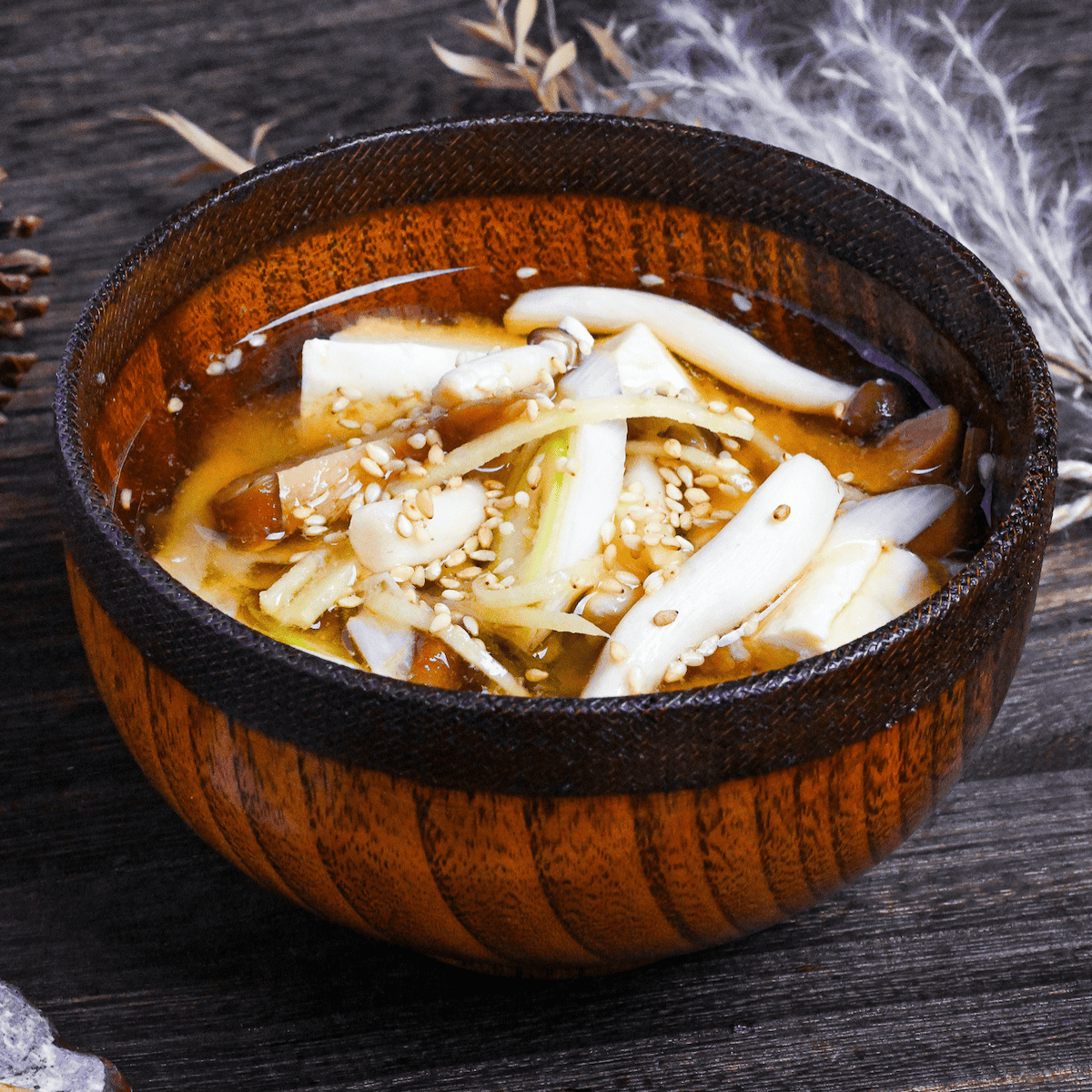
Vegan Miso Soup
Recipe Snapshot
- What is it? A soothing vegan miso soup infused with ginger, tofu, and mushrooms.
- Flavor profile: Warm, Soothing, Aromatic
- Why you’ll love this recipe: It’s the kind of recipe that feels luxurious but fits a weeknight. Minimal prep, maximum flavor, zero stress.
- Must-haves: Kombu, Dried shiitake mushrooms, Miso strainer or similar fine mesh strainer
- Skill Level: Easy
- Suitable for Meal Prep? Yes!
Summarize & Save this content on:
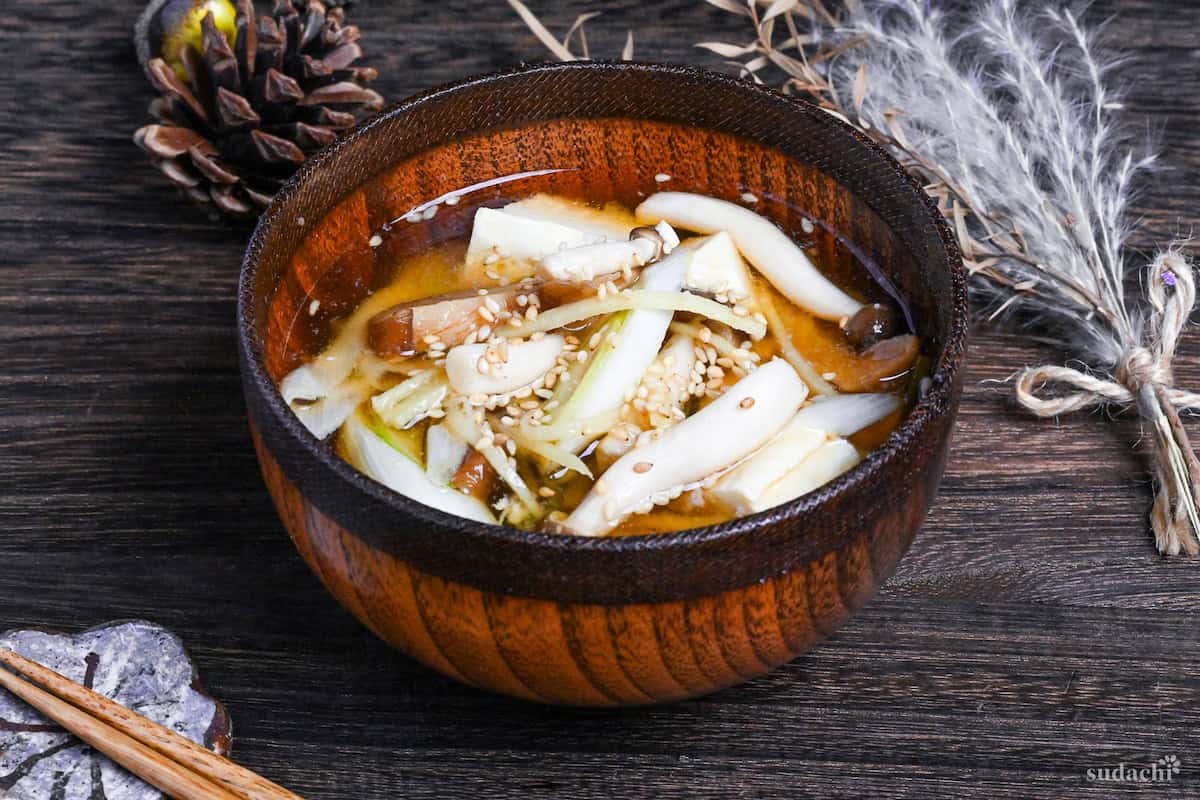
Is Japanese Miso Soup Vegan Friendly?
At first glance, miso soup looks perfectly vegan, just broth and miso paste, right? Not quite.
Our usual awase dashi often includes bonito flakes or dried sardines, which means most restaurant versions aren’t vegan. Even some modern miso pastes hide seafood extracts, so labels matter.
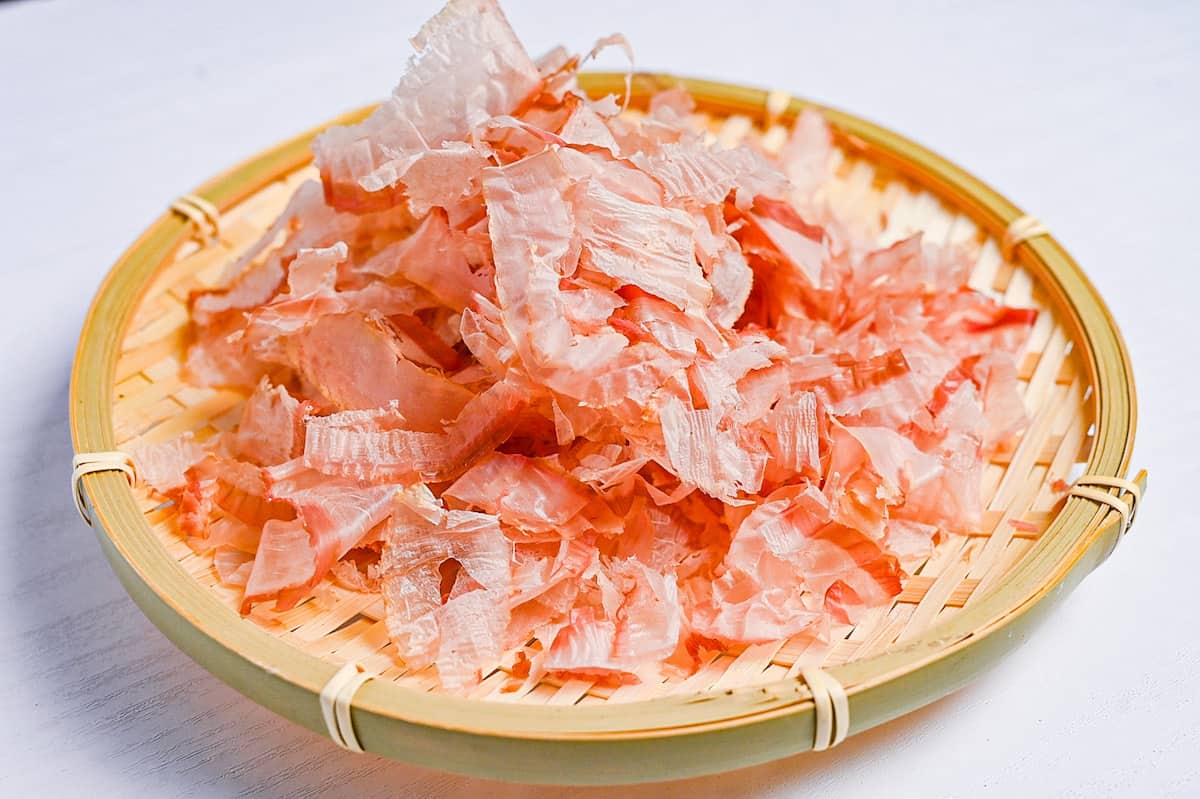
The good news? Japan has its own ancient vegan dashi called “shojin dashi (精進出汁), made from kombu and shiitake mushrooms. No compromise on umami! In the next section, you’ll see how to use it to create a miso soup that’s as authentic as it is plant-based.
How to Make Your Miso Soup Vegan Friendly
Transforming authentic Japanese miso soup into a plant-based version comes down to three choices: dashi stock, miso paste, and toppings. Here’s how to navigate each one.
1. Vegan-Friendly Dashi Stock
Traditional Japanese dashi uses bonito flakes (dried fish) and kelp, sometimes with dried sardines. For vegan dashi, you’ll swap the fish for mushrooms while keeping that deep umami backbone.
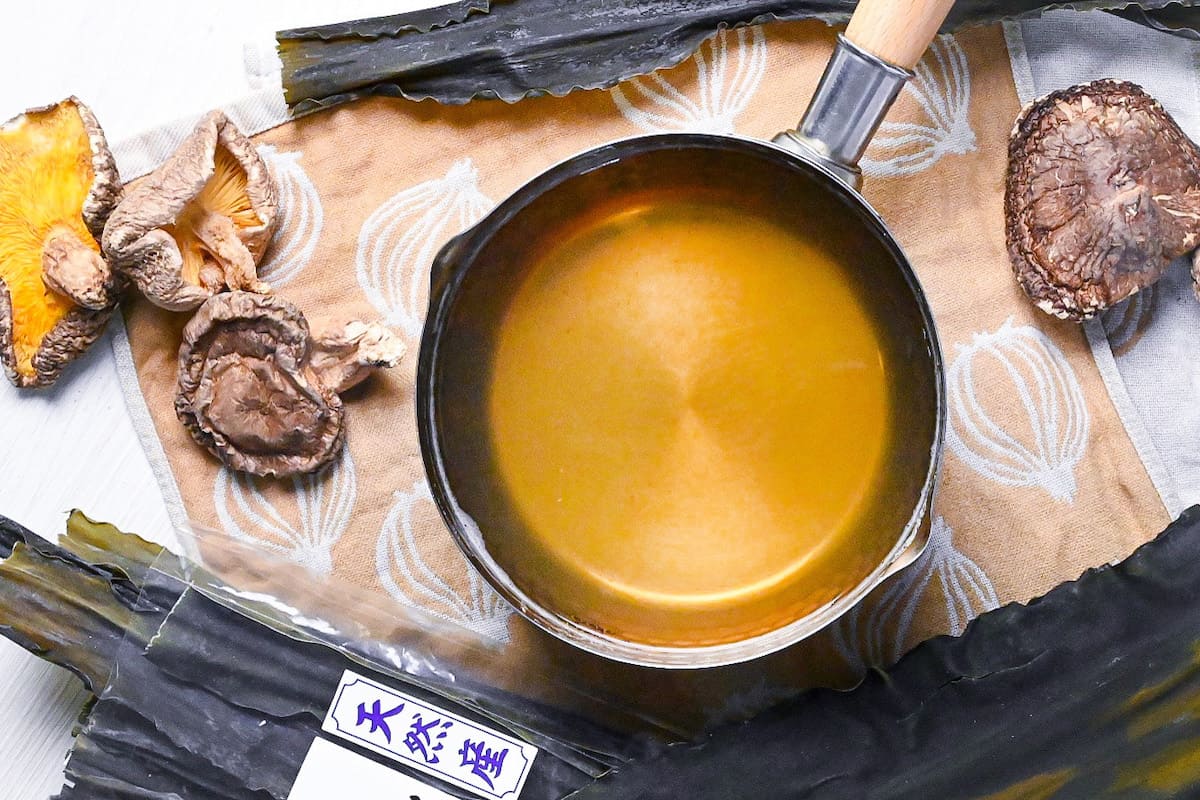
| Ingredient (Japanese) | What It Is | Vegan? |
|---|---|---|
| Kombu (昆布) | Dried kelp | ✅ Yes |
| Katsuobushi (鰹節) | Bonito flakes | ❌ No |
| Niboshi (煮干し) | Dried sardines | ❌ No |
| Shiitake (椎茸) | Dried shiitake mushrooms | ✅ Yes |
| Ago (あご) | Flying fish | ❌ No |
| Daizu (大豆) | Soybeans | ✅ Yes |
This recipe uses: Kombu + dried shiitake mushrooms, a classic plant-based combination that delivers authentic Japanese umami without compromise.
2. Choosing Vegan Miso Paste
Most miso paste is naturally vegan (made from koji rice, soybeans, and salt), but watch out for two traps:
- Dashi-infused miso (“dashi iri miso” 出汁入り味噌), convenient but contains fish stock.
- Seafood additives, some brands sneak in bonito or anchovy extracts.
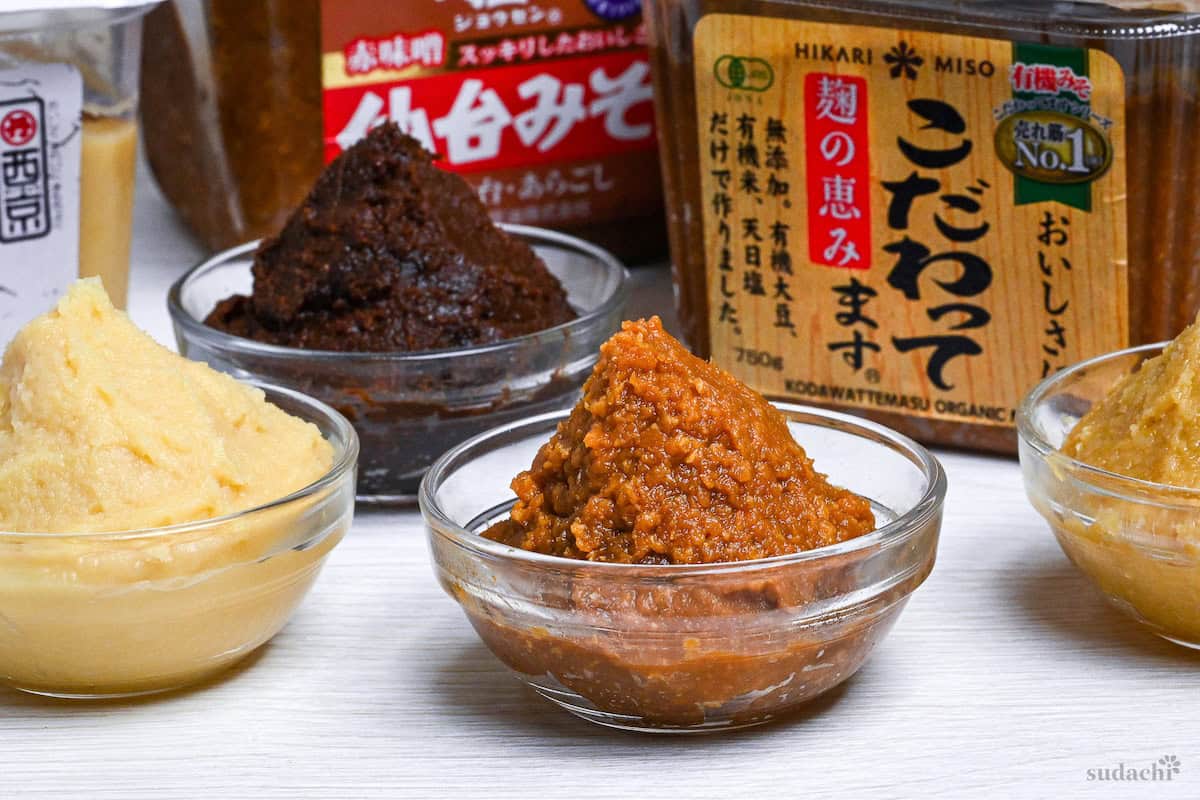
What you’ll want to look for are:
- Plain miso paste with no dashi added.
- Ingredient list: koji, soybeans, salt (that’s it).
- Labels like “organic,” “no additives,” or “gluten-free” often indicate cleaner formulations.
Recommended: Marukome’s organic awase miso. For a deeper dive into miso types, check my miso paste guide.
3. Ingredients & Toppings (The Easy Part)
Good news: Most traditional miso soup toppings are already plant-based. Japanese home cooks build miso soup around vegetables, tofu, and seaweed. Meat or fish versions (like salmon miso soup) are the exception, not the rule.
Proteins:
- Tofu (silken, firm or fried tofu pouches)
Vegetables:
- Mushrooms
- Daikon radish
- Green onion / Japanese leek
- Potato
- Eggplant
- Spinach
- Okra
Sea Vegetables:
- Wakame seaweed
This recipe features: Firm tofu, ginger, Japanese leek, and mushrooms.
Bottom line
Swap fish-based dashi for kombu-shiitake, choose plain miso paste, and load up on vegetables. You’ll have an authentic Japanese miso soup that’s fully plant-based. No sacrifices needed.
Ginger Miso Soup Ingredients
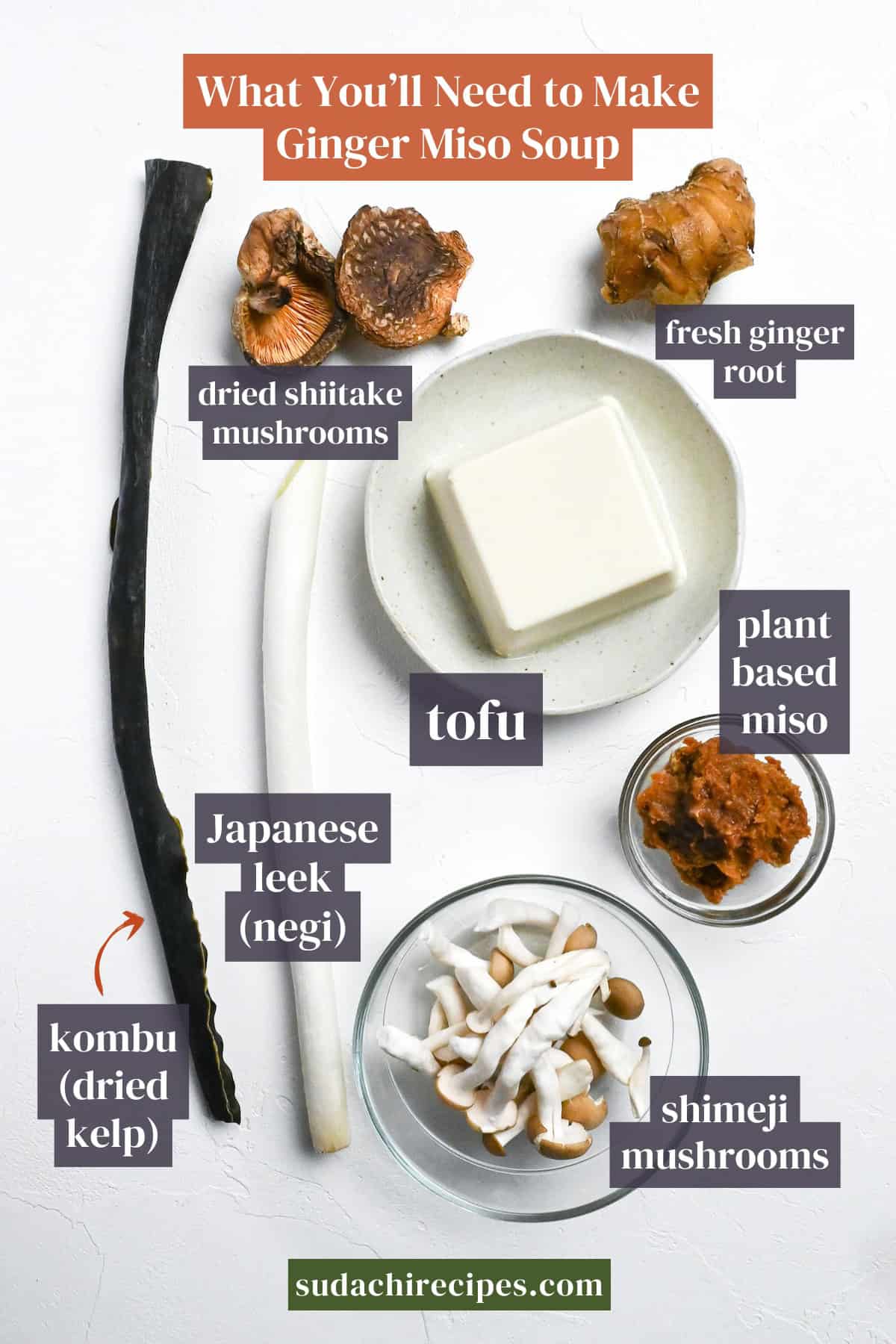
- Tofu: Choose silken for custardy spoonfuls or firm for tidy, bouncy cubes. You’ll find both at major grocers and at Asian markets.
- Japanese leek (naganegi): A tender, sweet-aromatic allium, think scallion flavor with a leek-like white shank that turns silky in hot soup. Often stocked at Asian grocers. Sub with the white/light-green part of a regular leek (cook a bit longer) or similar.
- Mushrooms: I used shimeji because I live in Japan, but honestly, this is your chance to use whatever mushrooms you love or can easily grab. Cremini, shiitake, oyster, even basic button mushrooms. They all bring that earthy, umami-rich depth that makes miso soup feel cozy.
- Miso paste: Look for a plain miso paste without dashi already mixed in. I recommend Marukome Organic Miso, but any plain mixed (awase) miso will work.
How to Make My Vegan Miso Soup
If you prefer to watch the process in action, check out my YouTube video of this ginger miso soup recipe!
i. Slide the kombu and dried shiitake into a pot of cold water, making sure they’re fully submerged. For weeknights, a 30-60 minute soak works, for deeper umami, refrigerate 5-24 hours in the fridge.
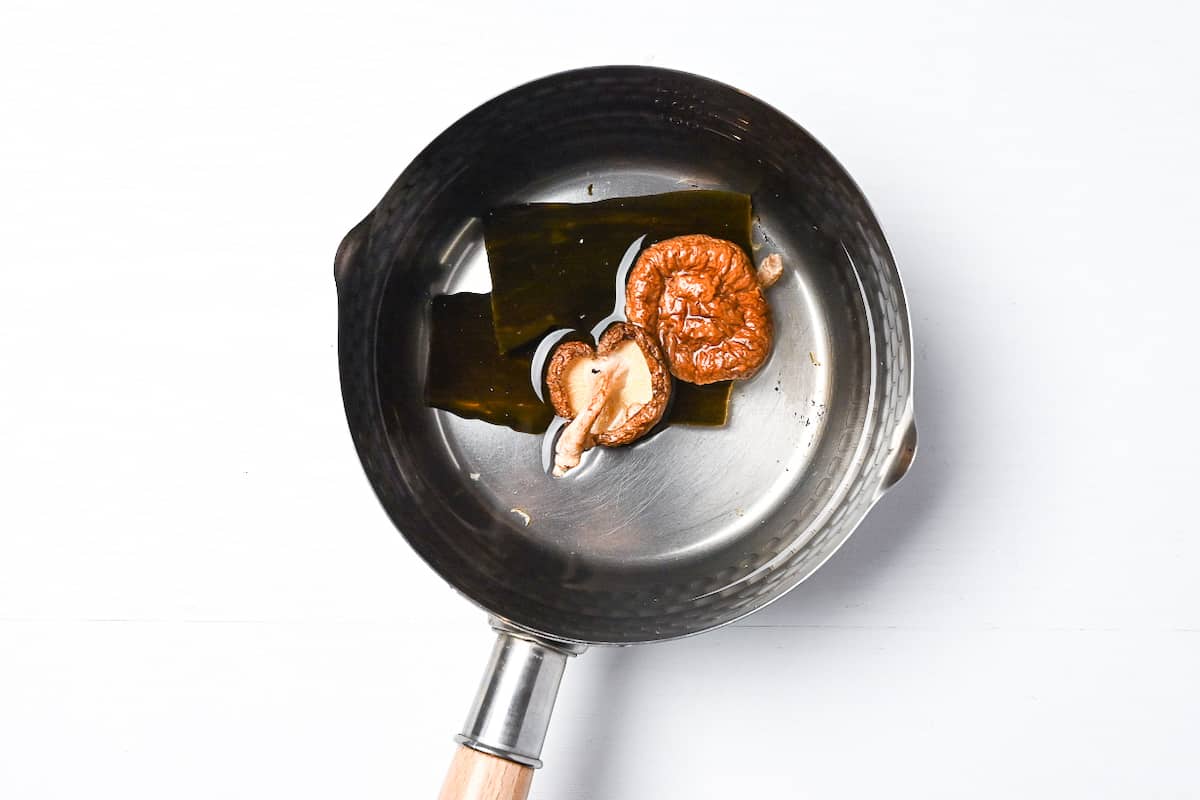
ii. If caps float, press them down with an otoshibuta or a small plate to keep everything under the surface.
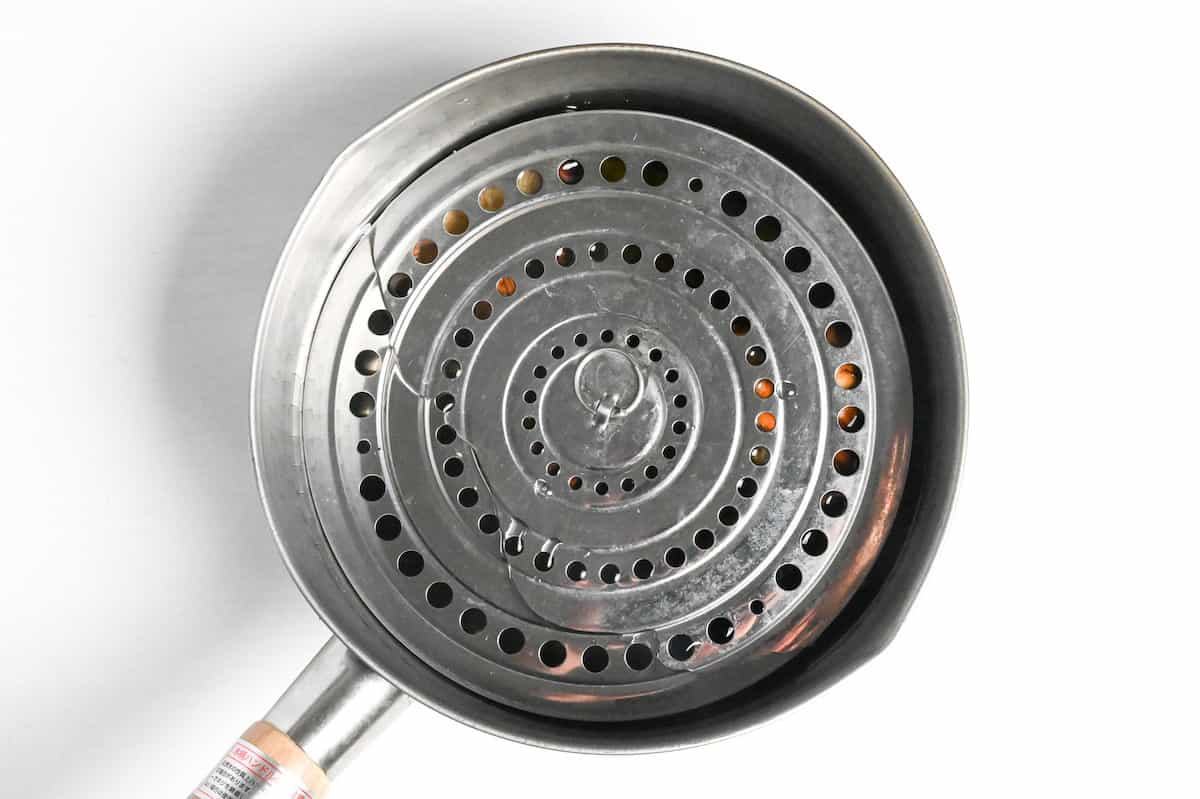
Dried shiitake are rich in guanylate, and kombu supplies glutamate. Together they create umami synergy that tastes fuller and longer-lasting than either alone. A cold soak favors guanylate extraction and sets you up for that synergy once you heat the broth.
i. Set the pot over medium-low heat and warm gently until the surface shivers and tiny bubbles gather at the edges, about 85-90℃ (185-194°F). Lift out the kombu and shiitake right before it boils to keep the broth clear and clean-tasting.
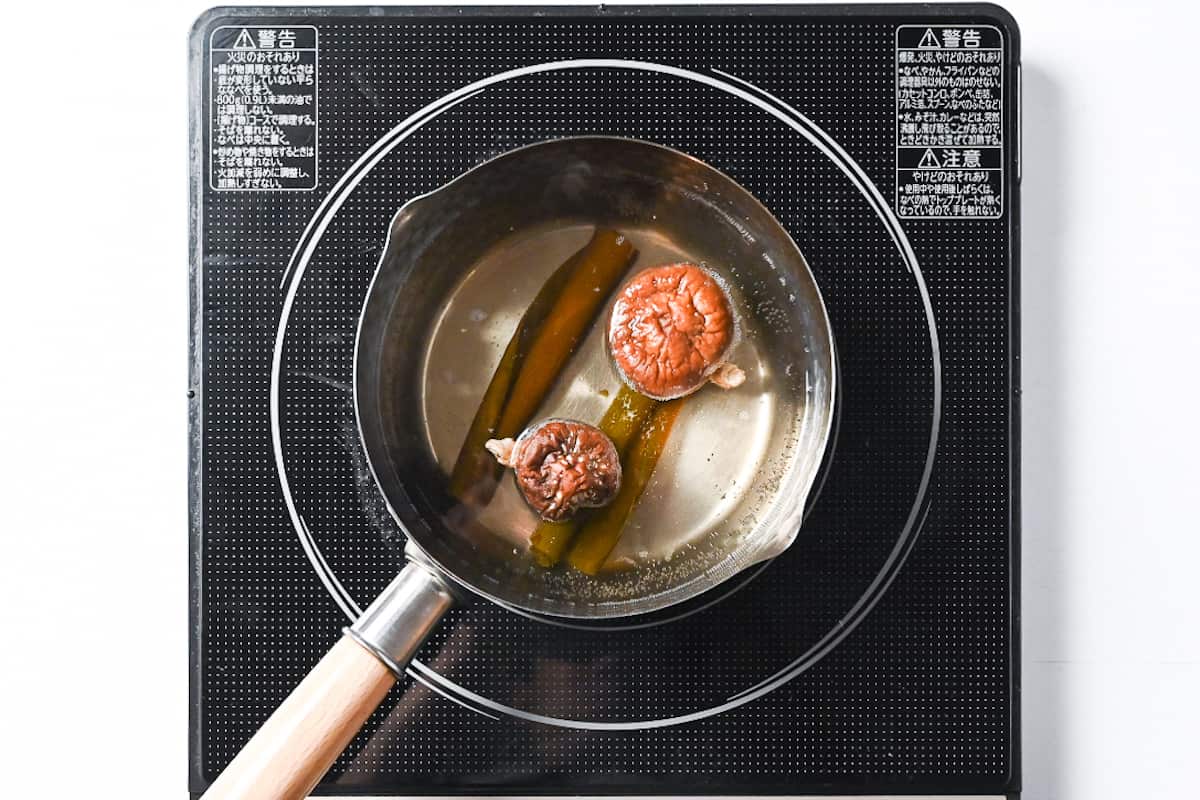
Boiling kombu can pull bitter, slimy notes. Staying just under a boil avoids those off-flavors and preserves a delicate aroma. Think tiny dancing bubbles, not a rolling boil.
i. Julienne a little fresh ginger for a gentle warmth, slice the Japanese leek (negi) on a diagonal for more surface area, and cut tofu into bite-size cubes. Leave small mushrooms like shimeji whole or separate into clusters so they keep a pleasant bounce.

Angle the knife and the stalk slightly, then slice in even strokes. This exposes more surface, releasing fragrance into the bowl without shredding the fibers. It’s quick, pretty, and perfect for soup.
ii. Bring the dashi back to a gentle simmer, aim for 80-85℃ (176-185°F). Hard vegetables (if you use carrot, potato, gobo) go first until just tender, then add tender veg and tofu to warm through without breaking.
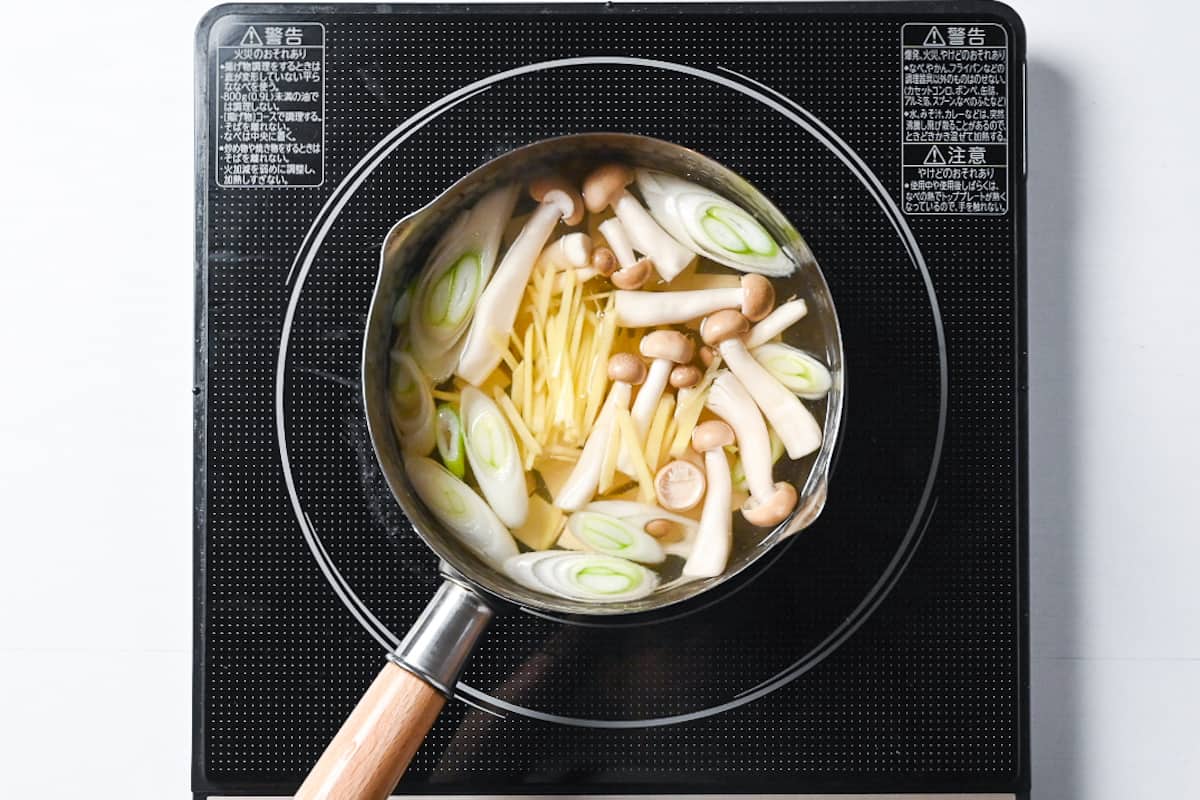
Finely slice some of the rehydrated kombu and shiitake and stir them back into the pot for bonus texture, flavor and reduced waste.
i. Turn off the burner and let the broth cool briefly to 70-75℃ (158-167°F). Hot enough to melt miso, but not to mute its aroma. Place miso in a mesh ladle or strainer, dip it into the hot broth, and whisk/press until silky.
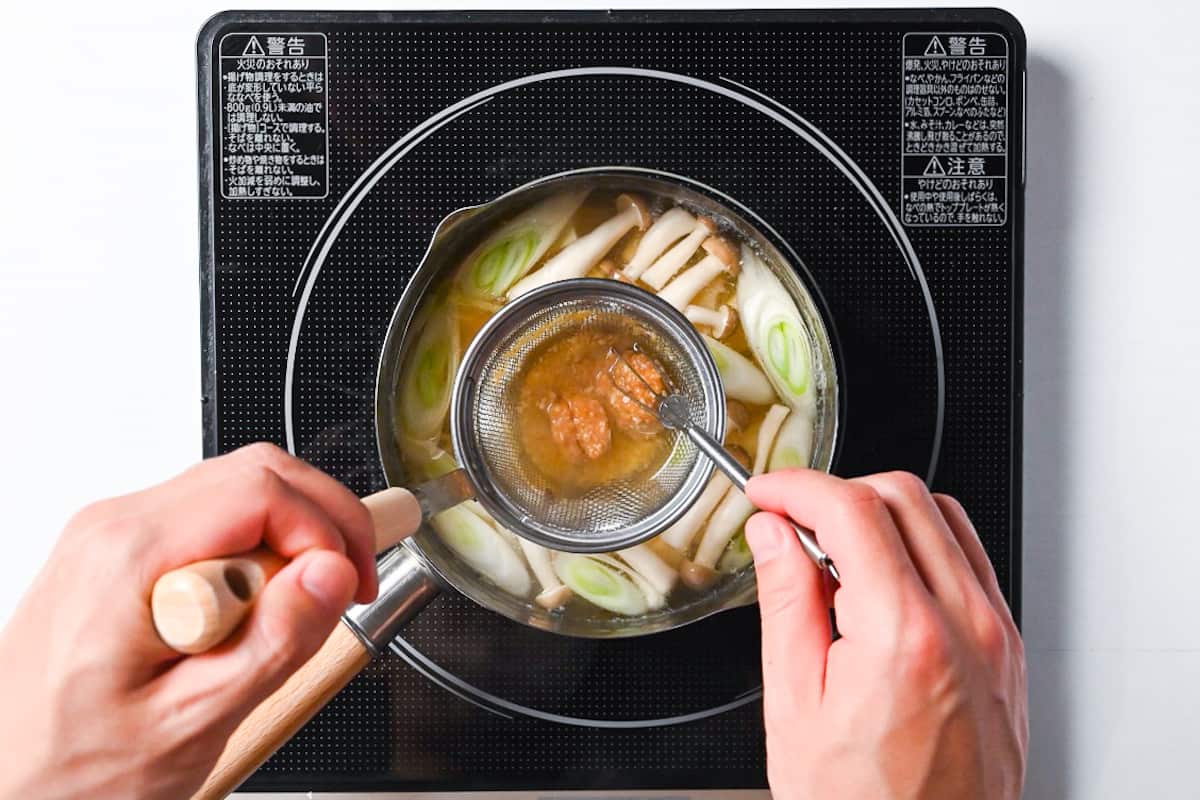
Your cue is a softly cloudy broth that smells toasty-soy, not sharp.
For best flavor (and if you care about live cultures), keep miso below a light simmer: enzymes and probiotic bacteria are heat-sensitive and lose activity as you pass ~60℃ (140°F), while flavor volatiles flash off at higher temps. That’s why we stir miso in off heat.
i. Ladle into bowls, give a gentle stir to keep the miso suspended, and finish with sliced green onions and toasted sesame seeds.
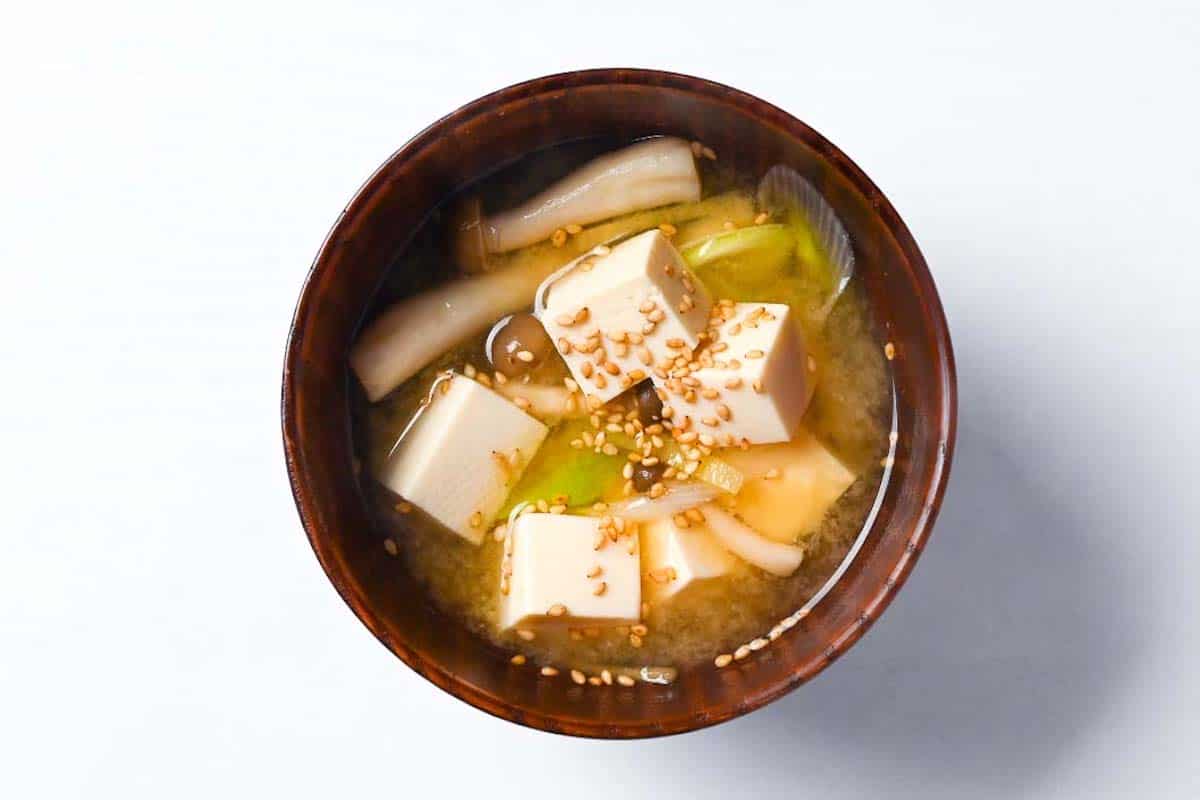

Essential Tips & Tricks
- Soak kombu and shiitake in cold water.
- Remove kombu just before boiling (85-90℃ / 185-194°F) to avoid sliminess and bitterness.
- Always add hard vegetables first and tofu or leafy greens last to keep textures balanced.
- If using potatoes or other starchy vegetables, boil them separately to avoid clouding the dashi.
- Turn off the heat before whisking in miso. It should melt in 70-75℃ (158-167°F) broth so the aroma stays intact.
- Garnish right before serving.
With these simple tips in mind, you’re set for success every time you make vegan miso soup.
Storage & Meal Prep
Fridge: Store leftover miso soup in an airtight container once it has cooled slightly (within 1 hour). Keep refrigerated for up to 24 hours, but expect the flavor and aroma to dull over time. Before reheating, stir well as miso tends to settle at the bottom.
Freezer: Not recommended. Instead, freeze dashi alone in portions for up to 1 month, then combine with fresh miso and tofu when serving.
Meal Prep: For a prep-friendly shortcut, make and store the kombu-shiitake dashi ahead of time (fridge 5-7 days or freezer 1 month).
Reheating: Warm refrigerated miso soup gently over low heat (60-70℃ / 140-158°F), stirring to reincorporate miso. Do not boil, as this destroys its delicate aroma and enzymes.
What to Serve With This Recipe
Vegan Miso Soup Q&A
Look for kome (rice) miso or any miso labeled gluten-free. Skip mugi (barley) or wheat-based miso, as they contain gluten.
Most miso is naturally vegan since it’s fermented from soybeans, rice, or barley with koji, not animal products. However, do make sure to check the labels as ingredients vary depending on the brand and whether it contains dashi.
Not recommended. Miso’s aroma deteriorates and tofu turns rubbery when frozen. Instead, freeze dashi alone and add fresh miso and tofu when reheating-it tastes freshly made with minimal effort.
Yes, slice them thinly and add back into the soup or stir-fry them to make kombu onigiri for a zero-waste boost of umami and fiber.

More Plant-Based Japanese Recipes
- Kenchin Jiru (Traditional Japanese Vegetable Soup)
- Tofu Gyoza (Plant Based)
- Plant-Based Mabo Nasu (Japanese Mapo Eggplant)
- Spicy Vegetarian Miso Ramen
Looking for more ideas? Check out my vegetarian Japanese recipes where you’ll find a diverse selection of dishes that capture authentic flavors.
Did You Try This Recipe?
I would love to hear your thoughts!
💬 Leave a review and ⭐️ rating in the comments below. 📷 I also love to see your photos – submit them here!
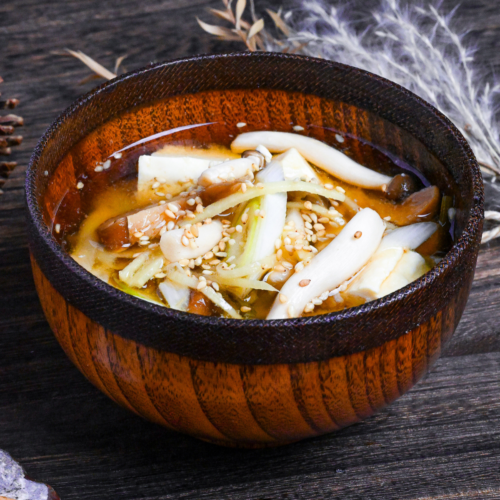
Japanese Ginger Miso Soup (Vegan)
Equipment
Ingredients
Dashi
- 500 ml cold water
- 6 g dried kelp (kombu)
- 4 g dried shiitake mushroom
Miso Soup
- 30 g Japanese leek (naganegi) or regular leek (simmer longer)
- 125 g firm tofu or silken for softer texture
- 20 g ginger root
- 30 g shimeji mushrooms or mushrooms of your choice
- 2 tbsp vegan miso paste I used awase/mixed miso
- ½ tbsp toasted white sesame seeds optional
My recommended brands of ingredients and seasonings can be found in my Japanese pantry guide.
Can’t find certain Japanese ingredients? See my substitution guide here.
Instructions
Plant Based Awase Dashi
- Place 6 g dried kelp (kombu) and 4 g dried shiitake mushroom in a pot with 500 ml cold water. Cover with a drop-lid or small plate to weigh down the mushrooms, and leave to soak for at least 30 minutes at room temp or 5-24 hours in the fridge.

- Once rehydrated, place the pot on the stove and heat over a medium setting until small bubbles appear around the edges (around 85-90℃/ 185-194°F). Remove the kombu and shiitake, you can discard them or finely slice them and add them back into the soup later depending on preference.

Miso soup
- Cut 30 g Japanese leek (naganegi) into diagonal pieces and 125 g firm tofu into cubes. Peel 20 g ginger root using a spoon and then cut into thin sticks (julienne). 30 g shimeji mushrooms can be left whole or sliced.

- Add the ginger, tofu, spring onion and mushroom to the dashi and cook until warmed through.

- Turn off the heat and add 2 tbsp vegan miso paste to a mesh spoon. Dip the spoon in the dashi and whisk the miso paste to incorporate it into the broth.*

- Pour the miso soup into serving bowls and top with a sprinkle of ½ tbsp toasted white sesame seeds and enjoy!

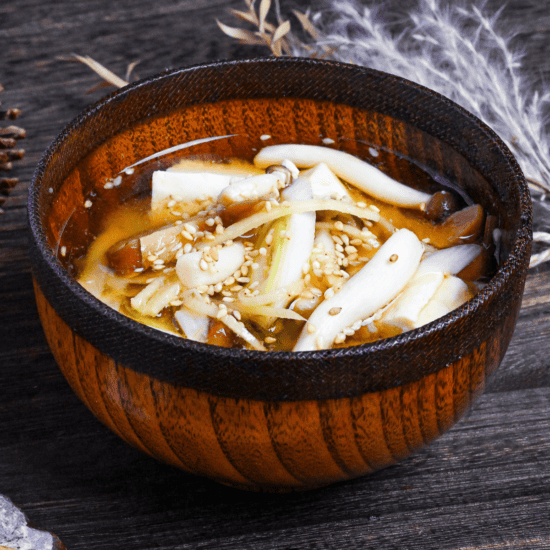




This is a very useful guide, ingredients can vary to taste and the tip to dissolve the miso is crucial! I don’t have a mashed spoon, so I use a cup and dissolve the miso with spoonfuls of dashi and then add.
Hi Dorothea,
Thank you so much for your comment and for sharing your experience. I’m glad that you found this article helpful! 🙂
Yuto